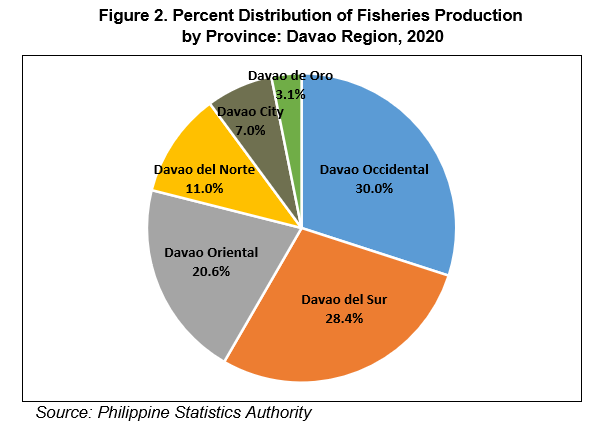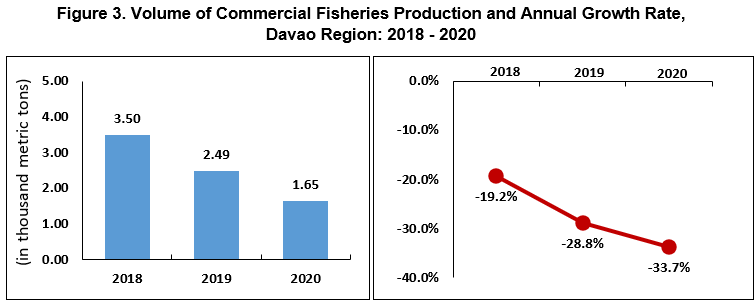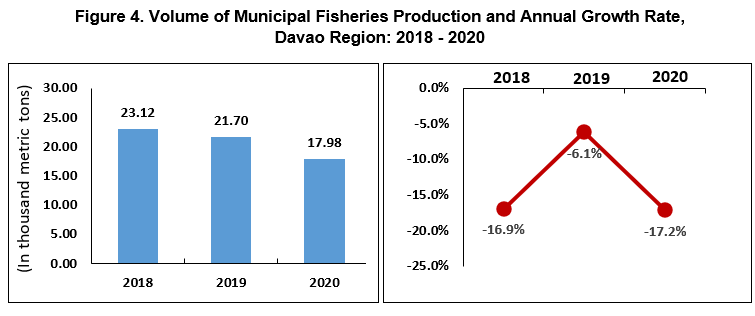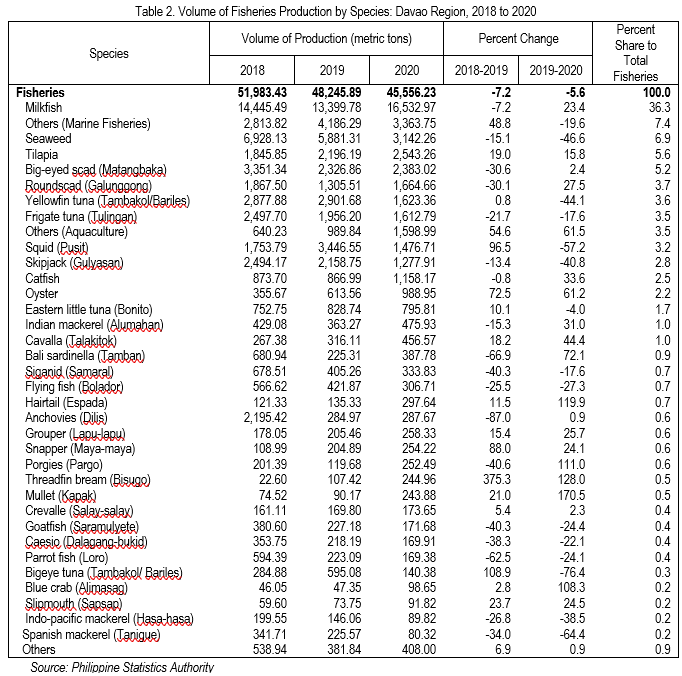Release Date :
Reference Number :
2021-013
 Fisheries production decelerates by 5.6 percent
Fisheries production decelerates by 5.6 percentOverall, the total volume of fisheries production of Davao Region was estimated at 45,556.23 metric tons during the year 2020. It decelerated by 5.6 percent compared from the previous year’s record of 48,245.89 metric tons.
Within the five-year period, Davao Region’s fisheries production showed a downward trend from 58,019.74 metric tons recorded in 2016 to the present production.
More than half (56.9 percent) of the 2020 regional fisheries outputs was attributed in the aquaculture subsector (or 25,926.11 metric tons). Municipal fisheries contributed 39.5 percent, composed of marine and inland fisheries at 38.7 percent (17,622.17 metric tons) and 0.80 percent (355.48 metric tons), respectively. Meanwhile, commercial fisheries’ total output showed the least contribution at 3.6 percent (1,652.47 metric tons).

By geographical location, the province of Davao Occidental contributed the biggest share at 30 percent (13,660.35 metric tons). Davao del Sur’s production drew closer at 28.4 percent (12,920.08 metric tons). Meanwhile, the fisheries production of Davao Oriental contributed to 20.6 percent (9,381.63 metric tons). It was followed by Davao del Norte and Davao City’s outputs at 11.0 percent (4,989.32 metric tons) and 7.0 percent (3,172.94 metric tons), respectively. On the other hand, Davao de Oro attributed a minimal production at 3.1 percent (1,431.91 metric tons).

Commercial fisheries volume of production was estimated at 1,652.47 metric tons in 2020, registering a 33.7 percent drop from the production of 2,490.76 metric tons a year ago.

In 2020, the municipal fisheries of Davao Region has a recorded production of 17,977.65 metric tons. This figure reduced by 17.2 percent from 21,704.67 metric tons output level in the prior year. The volume of municipal production was comprised of 98.1 percent marine fisheries, while the remaining was contributed by inland fisheries.

The regional volume of harvests from aquaculture farms inched up by 7.8 percent. The aquafarm’s output was posted at 25,926.11 metric tons, compared from the previous year’s mark at 24,050.46 metric tons.

The following species showed a dominant production during the reference year in Davao Region:
• Milkfish production was recorded at 16,532.97 metric tons, which exhibited a 23.4 percent improvement from the previous year’s level (13,399.78 metric tons).
• Other Marine Fisheries recorded an annual production of 3,363.75 metric tons. It went down by 19.6 percent from the 2019’s output at 4,186.29 metric tons.
• Production of Seaweed was estimated at 3,142.26 metric tons, which declined by 46.6 percent from the production of last year.
• Volume of harvests for Tilapia reached to 2,543.26 metric tons. It surpassed its 2020 output by 15.8 percent from 2,196.19 metric tons in the prior year.
• Big-eyed scad’s production was estimated at 2,383.02 metric tons, an increase of 2.4 percent from the level of output in the previous year.
• Roundscad rebounded its production at 1,664.66 metric tons (27.5 percent) compared from last year’s annual output at 1,305.51 metric tons.
• Yellowfin tuna has an annual production of 1,623.36 metric tons. It fell short by 44.1 percent from 2,901.68 metric tons of previous year’s production.


Technical Notes
This Special Release presents the data on volume of production of fisheries of the year 2020 in Davao Region. It contains information on the current situation by major species of the three (3) fisheries subsectors, namely: commercial and municipal fisheries, and aquaculture. It serves as output of the four (4) fisheries surveys regularly conducted by the Philippine Statistics Authority (PSA). The surveys are: Quarterly Commercial Fisheries Survey (QCFS), Quarterly Municipal Fisheries Survey (QMFS), Quarterly Inland Fisheries Survey (QIFS) and Quarterly Aquaculture Survey (QAqS).
Fisheries - all activities relating to the act or business of fishing, culturing, preserving, processing, marketing, developing, conserving and managing aquatic resources and the fishery areas including the privilege to fish or take aquatic resources thereof (RA 8550).
Commercial fishing – is the catching of fish with the use of fishing boats with a capacity of more than three gross tons for trade, business or profit beyond subsistence or sports fishing.
Marine Municipal Fishing - covers fishing operation carried out with or without the use of a boat weighing three gross tons or less.
Inland Municipal Fishing - the catching of fish, crustaceans, mollusks and all other aquatic animals and plants in inland water like lakes, rivers, dams, marshes, etc. using simple gears and fishing boats some of which are non-motorized with a capacity of three gross tons or less; or fishing not requiring the use of fishing boats.
Aquaculture - fishery operation involving all forms of raising and culturing of fish and other fishery species in marine, in fresh, brackish and marine water areas. The operation is comprised of activities from stocking to harvesting of species under controlled conditions in farming facility called aquafarm.
APPROVED FOR RELEASE:
RUBEN D. ABARO, JR.
Regional Director
